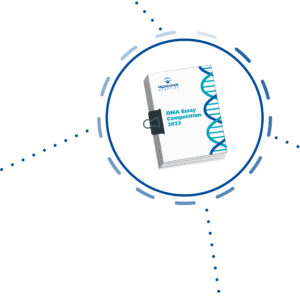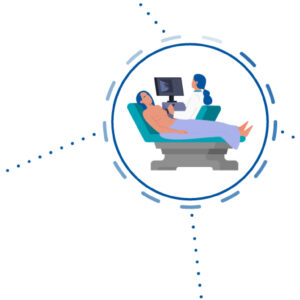BAP1-RELATED TUMOR PREDISPOSITION SYNDROME
BAP1 tumor predisposition syndrome is associated with an increased risk of various, comparatively rare tumor diseases: Spitz nevus (spindle cell nevus), uveal melanomas, malignant mesotheliomas, cutaneous melanomas, clear cell renal cell carcinomas and basal cell carcinomas. The average age of onset of the disease appears to be younger for carriers than for people affected in the general population. Uveal melanomas also show more aggressive disease progression with a higher risk of metastasis. Due to the few cases described at present, data on prevalence, penetrance and course of disease are not yet available. However, the penetrance seems to be incomplete and the tumor spectrum varies within a family.
Criteria for clinical diagnosis have not yet been established, but disease can be suspected in patients who meet one of the following criteria:
- at least two confirmed BAP1-associated tumors; or
- a BAP1-associated tumor and a first or second degree relative with a confirmed BAP1‑associated tumor (not basal cell carcinoma and/or cutaneous melanoma due to the high frequency in the general population).
BAP1 tumor predisposition syndrome is caused by pathogenic variants in the BAP1 gene and is an autosomal dominant inherited condition. Most carriers also have an affected parent, but the occurrence of de novo germline variants or mosaic variants cannot be excluded. So far, only point mutations in BAP1 have been described, but the occurrence of deletions or duplications of larger gene segments cannot be excluded either.
Consensus recommendations regarding screening check-ups for carriers have not yet been drawn up. However, performing annual check-ups of the eyes and skin for uveal melanoma or skin lesions has been suggested. With regard to renal cell carcinoma, preventative examinations can be carried out in accordance with those for von Hippel-Lindau syndrome. If a pathogenic variant has been identified in an affected person, blood relatives can be specifically tested for the variant on request after genetic counselling (predictive examination).
References
Repo et al. 2019, Hum Mol Genet 28:2415 / Masoomian et al. 2018, J Curr Ophthalmol 30:102 / Rai et al. 2016, Clin Genet 89:285 / Pilarski R et al. BAP1 Tumor Predisposition Syndrome. 2016. GeneReviews®: www.ncbi.nlm.nih.gov/books/NBK390611/
FAMILIAL ATYPICAL MULTIPLE MOLE MELANOMA SYNDROME
It is estimated that 11,000 men and 10,000 women in Germany develop malignant melanoma every year. Endogenous factors (high number of pigmentation spots, light skin tone) and high UV radiation exposure are the most important risk factors. Although melanoma in a first degree relative also increases the risk of developing melanoma. About 5-12% of melanoma diseases are genetic. Clinically, familial atypical multiple mole and melanoma syndrome (FAMMM) is suspected in patients with numerous nevi (>50) some with atypical features (asymmetric, raised, color variation, variable size) and one or more first or second degree relatives with melanoma.
FAMMM is caused by heterozygous pathogenic variants in the CDKN2A gene. CDKN2A encodes the protein p16, which interacts with cyclin-dependent kinase 4 (CdK4) and thus prevents cells from entering the G1 phase of the cell cycle. However, a pathogenic variant does not lead directly to tumor development. Only after failure of the second intact CDKN2A allele due to spontaneous somatic variants can increased proliferation and degeneration of the affected cell occur. According to studies, about 40% of those affected with FAMMM are carriers of a pathogenic CDKN2A variant. The risk for melanoma is reported to be 58-92% until the age of 81. The risk of developing pancreatic carcinoma also appears to be increased and is estimated to be about 17% by the age of 76. However, variable penetrance and expressivity are described. In a few families in which no change in CDKN2A could be detected, variants in the CDK4 and POT1 genes were identified, which are probably also a cause of FAMMM. Further susceptible genes are currently being discussed.
Descendants of carriers have a 50% risk of having inherited the variant known in the family. With regard to skin lesions and melanoma, FAMMM carriers and persons at risk (10 years and older) should have regular skin examinations of the entire body and should be encouraged to examine themselves.
References
Eckerle Mize D et al. 2019 Familial Atypical Multiple Mole Melanoma Syndrome. Cancer Syndromes: www.ncbi.nlm.nih.gov/books/ NBK7030/ / Rossi et al. 2019, Dermatol Pract Concept 9:10 / S3-Leitlinie zur Diagnostik, Therapie und Nachsorge des Melanoms, Version 3.1, 2018 / Read et al. 2016, J Med Genet 53:1/www.krebsdaten.de/krebs/DE/content/krebsarten/melanom/melanom_inhalt.html





















